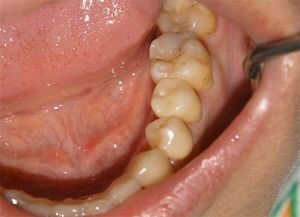 Caries - one of the most common dental diseases, appearing at any age, can occur in chronic and acute forms.
Caries - one of the most common dental diseases, appearing at any age, can occur in chronic and acute forms.
Sluggish chronic caries with time affects all tissues of the tooth. As a rule, the development of the disease occurs gradually, eventually damaging all layers of the dental tissue. The length of such a process can be estimated over the years and a person does not always suspect this.
Content of
Content
The chronic form of the disease is much more common than acute. In the course of the development of the disease, remission can last for several years or may worsen after exposure to provoking factors.
Most often, everything begins with the defeat of one tooth and if you do not resort to treatment in time, the pathology will pass to other teeth, gradually hitting the entire jaw.
The difficulty lies in the fact that chronic caries for a long time does not betray itself, and the symptoms are completely absent.
For example, acute incidence of toothache, which is not to say about the chronic form of the disease. In order to make a correct diagnosis, a comprehensive examination of the doctor is necessary.
As a rule, the transition from one stage to another occurs gradually and the patient does not notice it. This period lasts from several months to several years.
Initially, a white spot appears on the tooth, which subsequently becomes brown. If the stain remains white for a long time, then you need to contact the doctor, there is still the possibility of a complete cure without the use of cardinal measures.
Provoking factors
Sluggish caries appears for the same reasons as the rapidly progressing, so-called flowering. The factors, 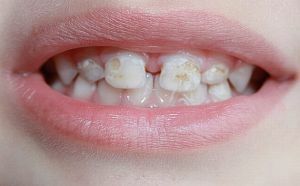 provoking the appearance of the disease, include the following:
provoking the appearance of the disease, include the following:
- lack of hygiene, which provokes the multiplication of bacteria on the teeth;
- unbalanced food, based on fast carbohydrates, - when choosing food, you need to remove the attention to those that contain vitamins and trace elements that strengthen tooth enamel;
- demineralization of enamel due to pathologies of a general nature.
Most often, any stomatological disease develops precisely because of a lack of hygiene. In this regard, bacteria begin to multiply and process acids and carbohydrates. Over time, the enamel gradually disintegrates and if in that case do not proceed to treatment, then the other parts of the tooth will start to be affected.
Baby teeth - in the risk zone
Practice shows that chronic caries of the baby teeth is the most common dental disease among toddlers.
The main reason for this phenomenon can be called the fact that parents do not always start taking care of the child's teeth in time. In order to avoid the development of lesions, you need to start brushing your teeth after the first incisor appears.
If you do not brush your teeth regularly, the saliva will stop suppressing the activity of the bacterium and fight the diseases that have arisen in the mouth.
 The main mistake of the parents is that they do not consider dental caries "milk" as a serious diagnosis, and therefore do not start its timely treatment.
The main mistake of the parents is that they do not consider dental caries "milk" as a serious diagnosis, and therefore do not start its timely treatment.
Do not think that you do not need to take care of your baby's teeth, just because they will change to indigenous ones. But in fact the health of the baby teeth depends on how strong the molars will be.
Very often, children under the age of two develop a bottle caries, which is provoked by night feeding from bottles. Despite the fact that in children under one year this disease is rare, it proceeds hard with a large-scale lesion.
Stages of development of
On its destructive pathway caries goes through 4 stages:
- Spot Stage .This period almost does not manifest itself at all and it is difficult to suspect a simple person about it. In some cases, the tooth reacts to cold and hot food. The carious part is a white spot.
- Surface .At this stage enamel is affected, which becomes dark.
- Average .At this stage, the disease affects the dentin.
- Deep .This type of disease differs from the previous one by the depth of the lesion and affects the roots and cement.
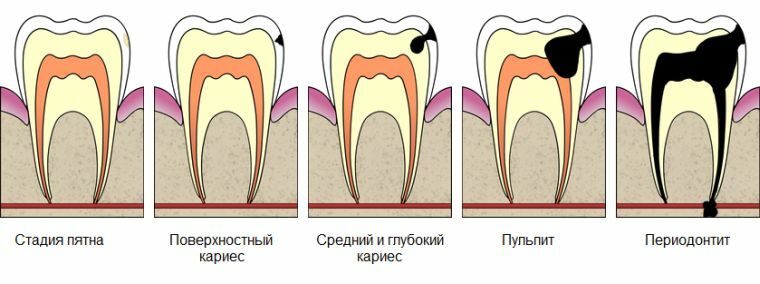
Features of the clinic and diagnostics
To distinguish chronic caries from acute can only be experienced by an experienced doctor with a thorough examination. Symptoms of the disease, in particular, include the following manifestations:
- darkening of the enamel;
- more dense enamel in place of darkening;
- is a secondary dentin in a deep cavity that only a doctor can detect;
- rough surface on the site of damage;
- tooth soreness after eating sweet.
In the chronic course of the disease, not the entire crown is affected. Initially, the enamel suffers, then dentin and pulp. When enamel is affected, the symptoms appear only externally: it changes its shade. And only when the pulp is affected does the patient feel painful sensations.
Diagnosis of caries consists of examining the patient, collecting anamnesis and applying additional research methods.
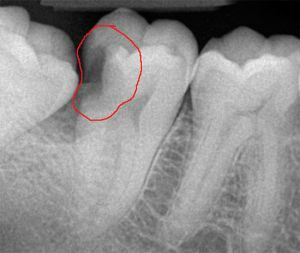
Caries on X-ray
But, as a rule, people learn about such a disease by accident, coming to a routine examination of the dentist, since their symptoms do not bother.
After examining the patient, the doctor can detect the disease visually: a carious cavity is formed inside the tooth, which can be filled with soft tissues or with food residues. If you take a picture of the X-ray, then on the site of the affected area you will be able to detect a dark spot.
If the doctor suspects of the presence of a latent form of the disease, in which the carious area, most often located under the seal, requires radiography.
From the practice of professionals
It can be said with confidence that sluggish and acute caries are two forms of illness that flow one from the other. For this reason, it is not always possible to distinguish them from each other even by an experienced dentist. To prevent the development of the disease you need to visit the dentist twice a year.
Oleg Viktorovich, dentist of the highest category
Every second my patient treats the problem of caries lesions of one degree or another of complexity - all this because I do not think about my health in a timely manner. If the patient addresses in a timely manner, then I manage to bring the patient's teeth back to normal.
Chronic caries is a common disease that occurs not only in adults, but also in children. To timely predict the disease and begin treatment must visit a regular dentist.
Anna Vasilievna, dentist-surgeon
Medical care
Treatment of chronic caries practically does not differ from acute therapy. The only difference is in the principles: therapeutic measures should be directed not only at eliminating the carious site, but also on the causes that caused the disease. The doctor can offer his patient such methods of recovery:
- Remineralizing therapy , which is based on saturation of enamel with phosphorus and calcium. Initially, the tooth
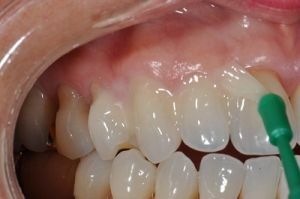 undergoes cleaning of the surface of the plaque, then the remineralization drug is applied to it and the doctor works as a lamp, which increases the effect of the preparation within 15-20 minutes. It is recommended to use calcium gluconate, applied in several layers. The remnants of the remedy are removed with a cotton swab. Duration of treatment and the number of procedures determined by the doctor, depending on the enamel damage.
undergoes cleaning of the surface of the plaque, then the remineralization drug is applied to it and the doctor works as a lamp, which increases the effect of the preparation within 15-20 minutes. It is recommended to use calcium gluconate, applied in several layers. The remnants of the remedy are removed with a cotton swab. Duration of treatment and the number of procedures determined by the doctor, depending on the enamel damage. - Deep fluoridation has a similar method of affecting the tooth surface. Difference only in the composition of the drug used, so to prevent the development of caries requires 2 components. The composition of the product includes phosphorus, fluorine and calcium. In order for the procedure to be more effective, the tooth is exposed to ultraviolet radiation before the application of the agent. Do this treatment in this way is not worth more than twice in the city. Due to the complex effect, tooth enamel is strengthened and it is possible to prevent the development of dental diseases.
- Sealing of fissures is indicated in the treatment of children. The principle of the procedure lies in the removal of the affected tissues and prevention of their penetration into the depth of the dentin. Cleansing one tooth lasts no more than 20 minutes.
- Sealing is necessary for the defeat of deep tissues. When the pulp is infected, it needs treatment or depulpation is necessary. Then the channels need to be sealed, the substance for this procedure is selected in accordance with the characteristics of the affected area. The duration of the procedure is not more than an hour. If you do not need to remove the nerve, then this time can be cut in half.
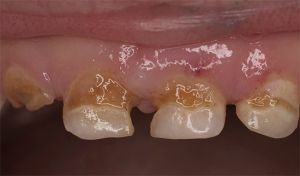 The first two methods are used to treat initial and superficial caries. With an average type of disease, sealing is shown, and with deep type - crowning.
The first two methods are used to treat initial and superficial caries. With an average type of disease, sealing is shown, and with deep type - crowning.
The choice of method of therapy remains with the doctor and primarily depends on the depth of the lesion. If the caries is superficial, then the treatment procedure will not be difficult, since it is not related to tissue preparation. Also important is the age of the patient.
Preventive measures
Prevention of the disease consists in preventing the causes that provoke it. Such measures include the following:
- use of rinsers and remineralizing ointments;
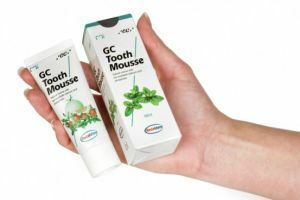
- timely access to a doctor;
- exclusion of sweets from the diet;
- use of chewing gums without sugar;
- visit to the dentist every six months, even if there are no problems;
- teeth cleaning after each meal with toothpicks.
If you adhere to all these rules, you will be able to maintain the health of the teeth and the entire oral cavity.
